BS24-U-IPEX Module Datasheet
Last Updated on : 2025-02-27 07:40:49download
This topic describes Tuya’s proprietary BS24-U-IPEX Bluetooth low energy (LE) module. It consists of a highly integrated wireless RF chip EFR32BG24 and a few peripheral components, with a built-in Bluetooth protocol stack and various library functions.
Overview
BS24-U-IPEX comes with a low-power 32-bit ARM Cortex-M33 core, 1024 KB of flash memory, 128 KB of RAM, and configurable GPIOs that can function as digital peripherals for various applications. This module integrates all MAC and TCP/IP libraries. All these resources can help develop your own embedded Bluetooth LE products.
Features
- Built-in low-power 32-bit CPU, ARM Cortex-M33 processor with DSP instructions and floating-point units can act as an application processor.
- Clock rate of 78 MHz.
- Wide operating voltage range: 2.0V to 3.8V.
- Peripherals: nine GPIO pins, one UART pin, two ADC pins, and five PWM pins.
- Bluetooth LE radio frequency (RF) features
- Compatible with Bluetooth LE 5.3
- RF data rate of up to 2 Mbit/s
- Transmitter power: +19.5 dBm
- Receiver sensitivity: -96 dBm@Bluetooth LE 1 Mbit/s
- Embedded hardware Advanced Encryption Standard (AES) encryption
- External FPC antenna with a gain of 1.5 dB
- Operating temperature: -40°C to +105°C
Scope of applications
- Smart building
- Smart home and electrical appliance
- Smart socket and light
- Industrial wireless control
- Baby monitor
- IP camera
- Smart bus
Updates
| Update date | Update content | Version |
|---|---|---|
| September 4, 2023 | The first release. | v1.0.0 |
Module interfaces
Dimensions and footprint
BS24-U-IPEX has three rows of pins. The pin spacing is 1.4±0.1 mm on both sides and 1.8±0.1 mm at the bottom.
The BS24-U-IPEX dimensions are 16.3±0.35 mm (L) × 15.8±0.35 mm (W) × 2.5±0.15 mm (H).

The following figure shows the dimensions and packaging design of the BS24-U-IPEX module.
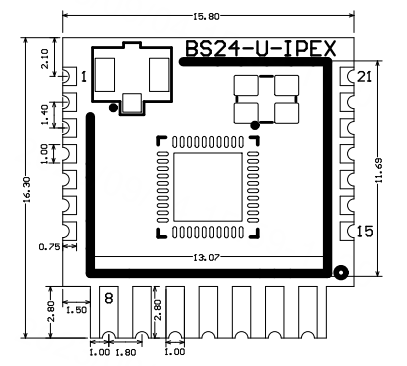
Pin definition
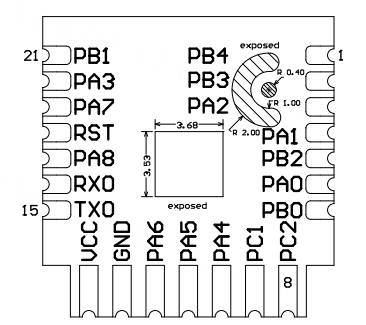
| Pin No. | Symbol | I/O type | Description |
|---|---|---|---|
| 1 | PB4 | I/O | GPIO pin, corresponding to PB04 on the IC. |
| 2 | PB3 | I/O | GPIO pin, corresponding to PB03 on the IC. |
| 3 | PA2 | I/O | Used for firmware flashing, SWDIO, corresponding to PA02 on the IC. |
| 4 | PA1 | I/O | Used for firmware flashing, SWCLK, corresponding to PA01 on the IC. |
| 5 | PB2 | I | ADC pin, corresponding to PB02 on the IC. |
| 6 | PA0 | I/O | GPIO pin, corresponding to PA00 on the IC. |
| 7 | PB0 | I/O | GPIO pin, corresponding to PB00 on the IC. |
| 8 | PC2 | I/O | Support hardware PWM, corresponding to PC02 on the IC. |
| 9 | PC1 | I/O | Support hardware PWM, corresponding to PC01 on the IC. |
| 10 | PA4 | I/O | Support hardware PWM, corresponding to PA04 on the IC. |
| 11 | PA5 | I/O | Support hardware PWM, corresponding to PA05 on the IC. |
| 12 | PA6 | I/O | Support hardware PWM, corresponding to PA06 on the IC. |
| 13 | GND | P | Ground pin. |
| 14 | VCC | P | Power supply pin (3.3V). |
| 15 | TX0 | I/O | UART_TXD0, used to flash the firmware and authorize the module, corresponding to PD03 on the IC. |
| 16 | RX0 | I/O | UART_RXD0, used to flash the firmware and authorize the module, corresponding to PD02 on the IC. |
| 17 | PA8 | I | ADC pin, corresponding to PA08 on the IC. |
| 18 | RST | I/O | Reset pin, corresponding to RESETn on the IC. It is effective when pulled down. |
| 19 | PA7 | I/O | GPIO pin, corresponding to PA07 on the IC. |
| 20 | PA3 | I/O | GPIO pin, corresponding to PA03 on the IC. |
| 21 | PB1 | I/O | GPIO pin, corresponding to PB01 on the IC. |
Pindicates the power pin, and I/O indicates the input and output pin.- Pins 3, 4, 13, 14, and 18 used for firmware flashing do not need to break out by default. Motherboard tracing shall keep away from these pins.
Electrical parameters
Absolute electrical parameters
| Parameter | Description | Min value | Max value | Unit |
|---|---|---|---|---|
| Ts | Storage temperature | -50 | 150 | °C |
| VBAT | Supply voltage | 2.0 | 3.8 | V |
| Electrostatic discharge voltage (human body model) | TAMB -25°C | - | 2 | kV |
| Electrostatic discharge voltage (machine model) | TAMB -25°C | - | 0.5 | kV |
Normal operating conditions
| Parameter | Description | Min value | Typical value | Max value | Unit |
|---|---|---|---|---|---|
| Ta | Operating temperature | -40 | - | 105 | °C |
| VCC | Operating voltage | 2.0 | 3.3 | 3.6 | V |
| VIL | I/O low-level input | - | - | IOVDD × 0.3 | V |
| VIH | I/O high-level input | IOVDD × 0.7 | - | - | V |
| VOL | I/O low-level output | - | - | IOVDD × 0.2 | V |
| VOH | I/O high-level output | IOVDD × 0.8 | - | - | V |
Power consumption in working mode
| Symbol | Condition | Typical value | Max value | Unit |
|---|---|---|---|---|
| Itx | Continuous transmission, with an output power of 19.5 dBm | 110 | 186 | mA |
| Itx | Continuous transmission, with an output power of 10 dBm | 38 | 59 | mA |
| Irx | Continuous reception | 7.3 | 9.7 | mA |
| IDC | Connected over Bluetooth mesh | 6.8 | 210 | mA |
| IEM2 | Deep sleep mode (RAM reserved) | 1.8 | 1.8 | μA |
RF parameters
Basic RF features
| Parameter | Description |
|---|---|
| Operating frequency | 2.4 GHz ISM band |
| Wireless standard | Bluetooth LE 5.3 |
| Data transmission rate | 1 Mbit/s and 2 Mbit/s |
| Antenna type | External FPC antenna |
Transmission performance
TX continuous transmission performance
| Parameter | Min value | Typical value | Max value | Unit |
|---|---|---|---|---|
| RF average output power | - | 19.5 | 20 | dBm |
| Bandwidth of 20 dB modulation signal (1 Mbit/s) | - | 2500 | - | kHz |
Receiving performance
RX sensitivity
| Parameter | Min value | Typical value | Max value | Unit |
|---|---|---|---|---|
| RX sensitivity 1 Mbit/s | - | -96 | - | dBm |
| RX sensitivity 2 Mbit/s | - | -93 | - | dBm |
| Frequency offset error 1 Mbit/s | -250 | - | +300 | kHz |
| Co-channel interference suppression | - | - | -10 | dB |
Antenna information
Antenna type
BS24-U-IPEX uses a first-generation IPEX antenna mount with the following structural dimensions:
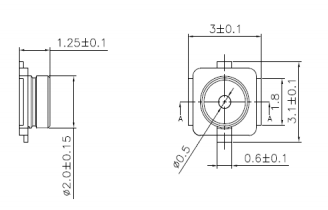
FPC-IPEX antenna is recommended. The following figure is for your reference.
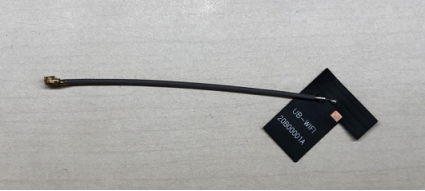
Antenna interference reduction
When the IPEX external antenna is fixed, the distance between the antenna and other mental components should be at least 15 mm to provide the best radiation performance.
Make sure that the enclosure surrounding the antenna is not metal materials. Otherwise, the radiation performance might be degraded. It is recommended to hollow out the breakout board around the antenna area.
Packing and production instructions
Mechanical dimensions
The PCB dimensions are 16.3±0.35 mm (W) × 15.8±0.35 mm (L) × 1.0±0.1 mm (H).

Side view
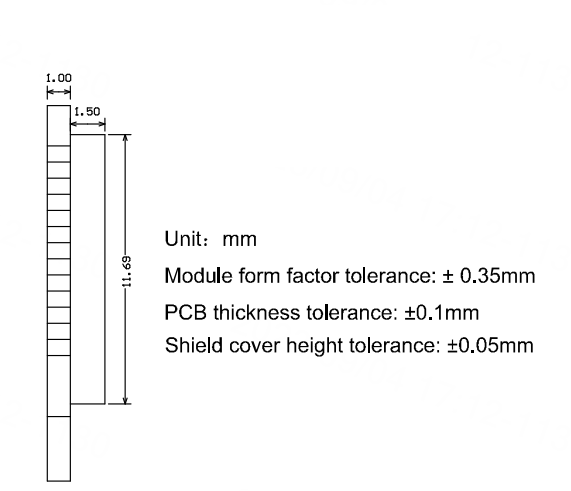
Schematic diagram
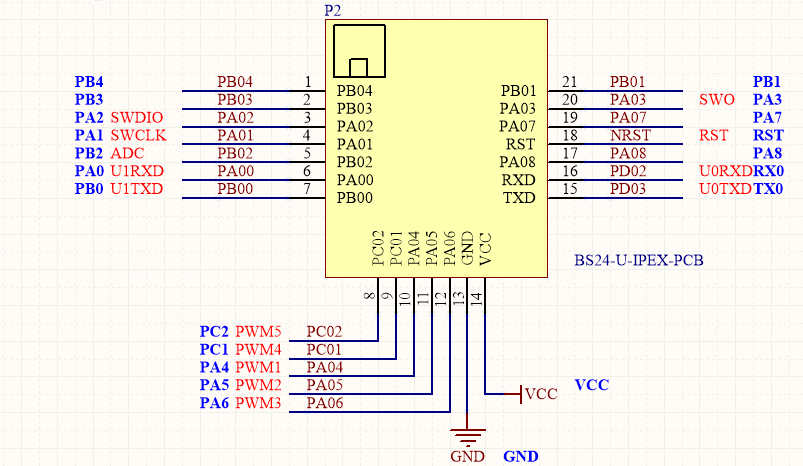
Recommended footprint

Production instructions
-
For the modules that can be packaged with the surface-mount technology (SMT) or in in-line form, you can select either of them according to the PCB design solutions of customers. If a PCB is designed to be SMT-packaged, package the module with the SMT. If a PCB is designed to use an in-line package, use wave soldering. Complete soldering within 24 hours after the module is unpacked. Otherwise, we recommend that you place the module in a drying cupboard with a relative humidity level below 10%, or pack the module in vacuum again. Then, record the packing time and duration of exposure. The total exposure time cannot exceed 168 hours.
- Instruments or devices required for the SMT process:
- Surface mount system
- SPI
- Reflow soldering machine
- Thermal profiler
- AOI
- Instruments or devices required for the wave soldering process:
- Wave soldering device
- Wave soldering fixture
- Constant-temperature soldering iron
- Tin bar, tin wire, and flux
- Thermal profiler
- Instruments or devices required for the baking process:
- Cabinet oven
- Anti-electrostatic and heat-resistant trays
- Anti-electrostatic and heat-resistant gloves
- Instruments or devices required for the SMT process:
-
A delivered module must meet the following storage requirements:
-
The moisture-proof bag must be placed in an environment where the temperature is below 40°C and the relative humidity is lower than 90%.
-
The shelf life of a dry-packaged product is 12 months from the date when the product is packaged and sealed.
-
A humidity indicator card (HIC) is put in the sealed package.
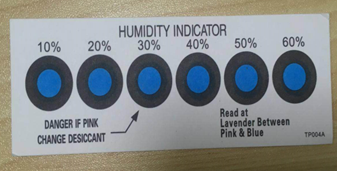
-
-
The module needs to be baked in the following cases:
- The vacuum packaging bag is damaged before unpacking.
- After unpacking, no HIC is found in the packaging bag.
- After unpacking, the HIC indicates a humidity level of 10% or higher. In this case, the circle turns pink on the HIC.
- The total exposure time has lasted for over 168 hours since unpacking.
- More than 12 months have passed since the first sealing of the bag.
-
The baking parameter settings are described below:
- Baking temperature: 40°C for reel packaging with relative humidity ≤ 5%. And 125°C for tray packaging with relative humidity ≤ 5% (use the heat-resistant tray, rather than plastic containers).
- Baking time: 168 hours for reel packaging and 12 hours for tray packaging.
- Temperature for triggering an alert: 50°C for reel packaging and 135°C for tray packaging.
- Production can begin after a module has cooled down to below 36°C under natural conditions.
- If a module remains unused for over 168 hours after being baked, it needs to be baked again.
- If a batch of modules is not baked after exposure for more than 168 hours, do not use reflow soldering or wave soldering to solder them. Because these modules are level-3 moisture-sensitive devices, they are very likely to get damp when exposed beyond the allowable time. In this case, if they are soldered at high temperatures, device failure or poor soldering performance might occur.
-
In the whole production process, take electrostatic discharge (ESD) protective measures.
-
To guarantee the pass rate, we recommend that you use the SPI and AOI to monitor the quality of solder paste printing and mounting.
-
With a built-in crystal oscillator, this product can generally be cleaned with an ordinary detergent or ultrasonic wave. However, in some cases, vibrations generated by an ultrasonic cleaner can damage the internal structure of the crystal oscillator. If you use an ultrasonic cleaner, you need to verify in advance to make sure the crystal oscillator inside the module is protected from any possible damage.
-
During product installation or processing, ultrasonic soldering is not recommended, because it might lead to excessive internal vibration or even failure of the crystal oscillator in the module.
Recommended oven temperature curve
Select a proper soldering technique according to the process. For more information, refer to the recommended oven temperature curve of either reflow soldering or wave soldering. The set temperatures might deviate from the actual temperature measurements. All temperatures shown in this module datasheet are obtained through actual measurements.
Technique 1: SMT process (recommended oven temperature curve of reflow soldering)
Set the oven temperatures according to the following curve.
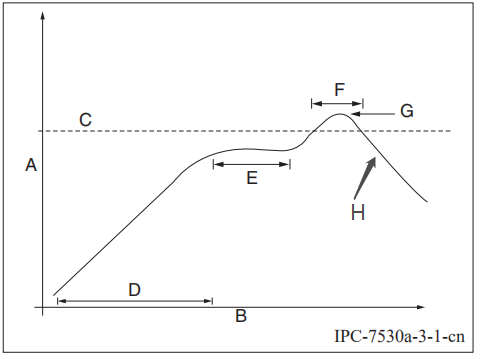
-
A: temperature axis
-
B: time axis
-
C: alloy liquidus temperature from 217°C to 220°C
-
D: ramp-up slope from 1°C/s to 3°C/s
-
E: keep a constant temperature from 150°C to 200°C for a time period of 60s to 120s
-
F: temperature above liquidus temperature for 50s to 70s
-
G: peak temperature from 235°C to 245°C
-
H: ramp-down slope from 1°C/s to 4°C/s
The curve above is based on solder paste SAC305. For more information about other solder pastes, see the recommended oven temperature curve in the specified solder paste specifications.
Technique 2: Wave soldering process (oven temperature curve of wave soldering)
Set the oven temperatures according to the following temperature curve of wave soldering. The peak temperature is 260°C±5°C.
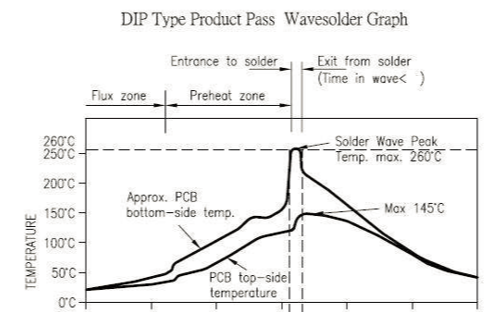
| Suggestions on wave soldering | Suggestions on manual repair soldering | ||
|---|---|---|---|
| Preheat temperature | 80°C to 130°C | Soldering temperature | 360°C ± 20°C |
| Preheat duration | 75s to 100s | Soldering duration | Less than 3s/point |
| Contact duration at the peak | 3s to 5s | N/A | N/A |
| Solder tank temperature | 260 ± 5°C | N/A | N/A |
| Ramp-up slope | ≤ 2°C/s | N/A | N/A |
| Ramp-down slope | ≤ 6°C/s | N/A | N/A |
Storage conditions
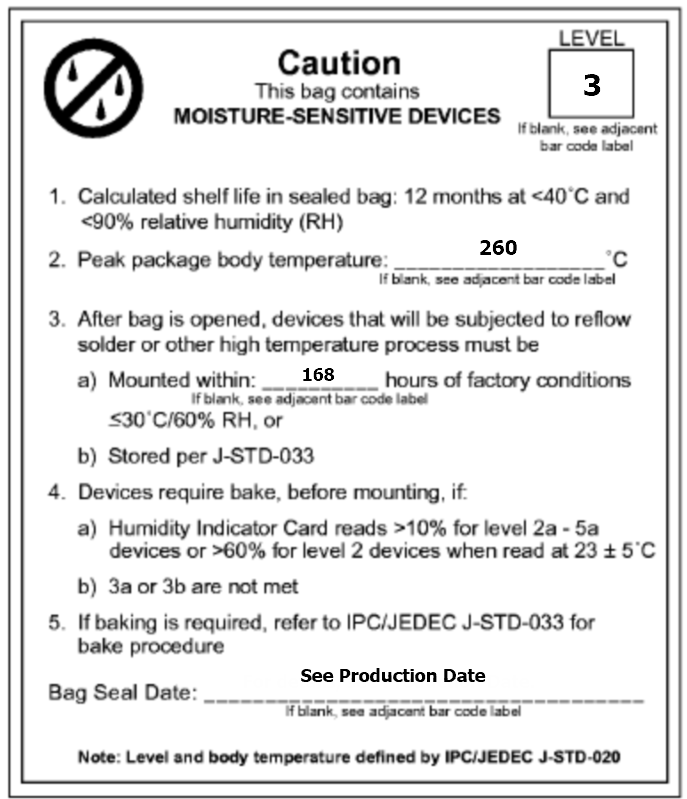
MOQ and packaging information
| Product model | MOQ (pcs) | Shipping packaging | Modules per reel (pcs) | Reels per carton |
|---|---|---|---|---|
| BS24-U-IPEX | 4,400 | Tape and reel | 1,100 | 4 |
Appendix: Statement
FCC Caution: Any changes or modifications not expressly approved by the party responsible for compliance could void the user’s authority to operate this device. The module is limited to installation in mobile or fixed applications. This device complies with Part 15 of the FCC Rules. Operation is subject to the following two conditions: (1) This device may not cause harmful interference, and (2) this device must accept any interference received, including interference that may cause undesired operation.
Note: This device has been tested and found to comply with the limits for a Class B digital device, according to part 15 of the FCC Rules. These limits are designed to provide reasonable protection against harmful interference in a residential installation. This device generates, uses, and can radiate radio frequency energy and, if not installed and used following the instructions, may cause harmful interference to radio communications. However, there is no guarantee that interference will not occur in a particular installation.
If this device does cause harmful interference to radio or television reception, which can be determined by turning the device off and on, the user is encouraged to try to correct the interference by one or more of the following measures:
- Reorient or relocate the receiving antenna.
- Increase the separation between the device and receiver.
- Connect the device to an outlet on a circuit different from that to which the receiver is connected.
- Consult the dealer or an experienced radio/TV technician for help.
Radiation Exposure Statement
This device complies with FCC radiation exposure limits set forth for an uncontrolled rolled environment. This device should be installed and operated with a minimum distance of 20cm between the radiator and your body. The OEM integrator is responsible for ensuring that the end-user has no manual instructions to remove or install the module.
Important Note
This radio module must not be installed to co-locate and operate simultaneously with other radios in the host system except by following FCC multi-transmitter product procedures. Additional testing and device authorization may be required to operate simultaneously with other radios.
The availability of some specific channels and/or operational frequency bands are country-dependent and are firmware programmed at the factory to match the intended destination. The firmware setting is not accessible to the end-user.
The host product manufacturer is responsible for compliance with any other FCC rules that apply to the host not covered by the modular transmitter grant of certification. The final host product still requires Part 15 Subpart B compliance testing with the modular transmitter installed. Separate approval is required for all other operating configurations including portable configurations with respect to Part 2.1093 and different antenna configurations.
The end-user manual shall include all required regulatory information/warnings as shown in this manual, including “This product must be installed and operated with a minimum distance of 20 cm between the radiator and user body”.
The RF module is considered as a limited modular transmitter according to FCC rules. Even though the RF module gets an FCC ID, the host product manufacturer can not use the FCC ID on the final product directly. In these circumstances, the host product manufacturer integrator will be responsible for re-evaluating the end product (including the transmitter) and obtaining the FCC authorization by a Class II permissive change application or a new application.
Declaration of Conformity European Notice

Hereby, Hangzhou Tuya Information Technology Co., Ltd declares that this module product is in compliance with essential requirements and other relevant provisions of Directive 2014/53/EU,2011/65/EU. A copy of the Declaration of Conformity can be found at https://www.tuya.com.

This product must not be disposed of as normal household waste, in accordance with the EU directive for waste electrical and electronic equipment (WEEE-2012/19/EU). Instead, it should be disposed of by returning it to the point of sale, or to a municipal recycling collection point.
The device could be used with a separation distance of 20cm from the human body.
Is this page helpful?
YesFeedbackIs this page helpful?
YesFeedback





